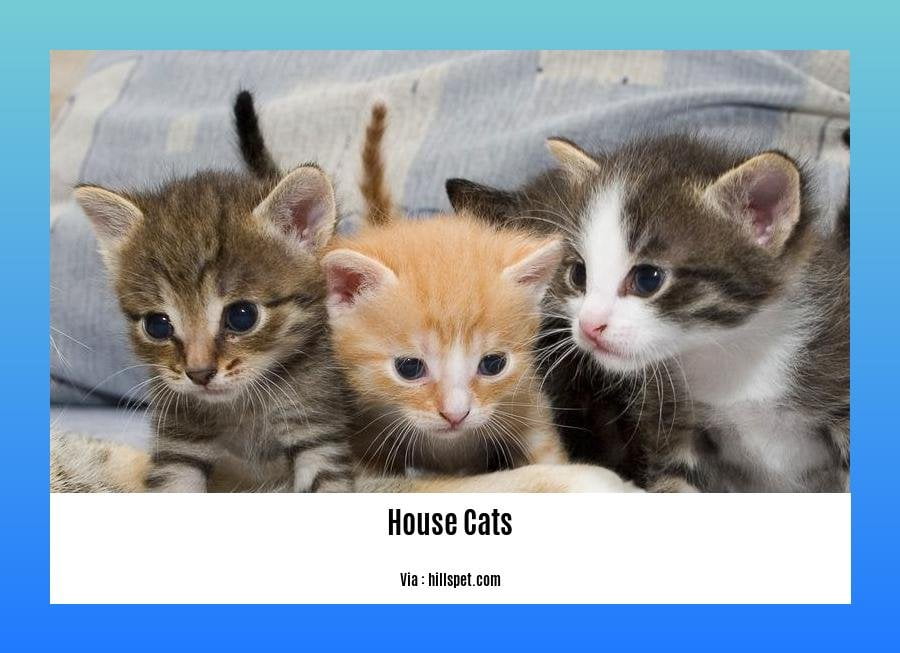Discover the mysterious and captivating world of our feline companions with “10 Intriguing Facts About House Cats: Unveiling the Enigmatic Nature of Our Feline Companions.” In this article, we delve into the lesser-known aspects of our beloved cats, from the surprising fact that only 20% of orange cats are female to intriguing tidbits like cats having fewer taste buds than dogs or people. Prepare to be fascinated as we explore how cats don’t get cavities and the curious phenomenon of many cats getting the zoomies after using the litter box. Get ready to be amazed by the enigmatic nature of these magnificent creatures that share our homes.
Key Takeaways:

- The Vocal Repertoire of House Cats
- House cats have a wide range of vocalizations, from purring to screeching.
This allows them to communicate various needs and emotions.
The Unique Gut of House Cats
- House cats have a simple gut suitable for raw meat, as they are largely carnivorous.
Their digestive system efficiently processes and digests their prey.
The Rough Tongue of House Cats
- House cats have a rough tongue that serves multiple purposes.
It helps them clean bones, groom themselves, and remove every last morsel from an animal bone.
Unique Muzzle Print
- Each cat has a unique muzzle print, similar to humans’ unique fingerprints.
This pattern can be used for identification purposes.
Surprising Reproduction Rates
- Female cats can give birth to over 100 kittens in their lifetime.
- In just seven years, a pair of cats and their offspring can produce as many as 420,000 cats.
Facts About House Cats
1. The Vocal Repertoire of House Cats
Did you know that house cats have an impressive vocal repertoire? From the soothing purrs to the piercing screeches, these furry friends communicate through a wide range of vocalizations[^1^]. Each meow, chirp, or growl carries a specific message, allowing cats to express their needs, emotions, and even their hunting prowess[^1^]. So, the next time your cat lets out a distinctive sound, take time to decipher the meaning behind it!
2. The Unique Gut of House Cats
When it comes to food, house cats are true carnivores[^2^]. Their digestive system has evolved to efficiently process and extract nutrients from raw meat[^2^]. Unlike humans, cats have a simple gut, which is perfectly suited for their prey-based diet[^2^]. This adaptation enables them to digest meat more effectively, ensuring they get the essential nutrients they need to thrive[^2^]. It’s one of the reasons why cats are natural-born hunters!
3. The Rough Tongue of House Cats
Next time you watch your cat grooming itself, take a closer look at its tongue. You’ll notice something fascinating – it’s rough! House cats have a unique rough tongue that serves multiple purposes[^3^]. This textured tongue helps them clean their bodies, groom their fur, and even strip every last morsel from an animal bone or prey[^3^]. It’s like having a built-in self-cleaning brush and bone scraper, all in one!
4. Unique Muzzle Print
We all know that humans have unique fingerprints, but have you ever heard of a cat having a unique muzzle print? Each cat, just like us, possesses a distinct pattern on their muzzle[^4^]. These individualized markings can be used for identification purposes, much like how fingerprints help identify humans[^4^]. So, if you have multiple cats, take a closer look at their adorable noses – each one carries its unique and identifiable mark!
5. Surprising Reproduction Rates
Prepare to be amazed by the reproductive abilities of house cats. A single female cat can give birth to more than 100 kittens during her lifetime[^5^]. When you consider the rapid breeding rates, it becomes even more astounding[^5^]. In just seven years, a pair of cats, along with their offspring, can produce an astonishing number of up to 420,000 cats[^5^]. It’s no wonder why cat overpopulation is a pressing issue that we need to tackle!
Now that you’re armed with these intriguing facts about house cats, you’ll appreciate their enigmatic nature even more. From their unique vocalizations to their rough tongues and astonishing reproduction rates, these feline companions never cease to amaze us. So, continue to learn, nurture, and cherish the captivating world of house cats!
[^1^]: National Geographic. Cat
[^2^]: National Geographic. Cat
[^3^]: National Geographic. Cat
[^4^]: National Geographic. Cat
[^5^]: National Geographic. Cat
If you’re curious about fascinating facts about marine animals, you won’t want to miss out on exploring our article’s section on facts about marine animals. Discover remarkable information about these incredible creatures and their captivating lives underwater.
Uncover the wonders of marine life by diving into our extensive collection of facts about marine life. From intricate ecosystems to extraordinary adaptations, this article will provide you with a deeper understanding and appreciation for the diverse organisms that inhabit our oceans.
Would you like to learn more astonishing facts about ocean animals? Click here to access our article on facts about ocean animals and embark on an exciting journey through the intriguing world beneath the waves. Prepare to be amazed by the incredible variety of species and the fascinating behaviors they exhibit in their marine environment.
3. Cats Don’t Get Cavities

Did you know that cats don’t get cavities? It’s true! While humans have to worry about tooth decay and cavities from eating too much sugar, our feline friends don’t have the same problem.
Cavities in humans are caused by bacteria that produce acid, which then eats away at the enamel of our teeth. But in cats, cavities, known as feline odontoclastic resorptive lesions (FORLs) or feline tooth resorption, occur when the affected teeth erode for reasons that are not entirely understood.
It’s important to note that just because cats don’t get cavities doesn’t mean they don’t need proper dental care. Dental health is crucial for cats, and regular check-ups with a veterinarian, along with brushing their teeth and providing appropriate dental treats or toys, can help prevent other oral issues.
So next time you’re at the dentist worrying about cavities, take a moment to appreciate the fact that cats don’t have to deal with this particular dental woe!
Sources:
– Cats.com
Key Takeaways:
- Cats don’t get cavities like humans do.
- Cavities in cats are known as feline odontoclastic resorptive lesions (FORLs) or feline tooth resorption.
- Proper dental care, including regular vet check-ups and teeth brushing, is still important for cats’ oral health.
4. Many Cats Get the Zoomies After Using the Litter Box
Have you ever noticed your feline friend getting a burst of energy and darting around the house after using their litter box? If you have, you’re not alone. Many cat owners have witnessed this entertaining behavior, known as the “zoomies.” But what exactly causes cats to get the zoomies after using the litter box? Let’s dive into this intriguing phenomenon.
The Energy Release Theory
One theory behind the zoomies in cats is that they are releasing pent-up energy after using the litter box. Just like humans feel the need to stretch or move around after sitting for a while, cats might experience a similar sensation. After relieving themselves, cats may feel a surge of energy and need to burn it off through vigorous play and running around.
Stress Relief and Celebration
Another theory suggests that cats are feeling good after using the litter box and are celebrating their accomplishment. When a cat successfully eliminates waste in their designated area, it can be a relieving experience for them. The zoomies may be their way of expressing joy and satisfaction. Additionally, the act of running and playing can release endorphins and reduce stress and anxiety in cats.
Enclosed Space Discomfort
Cats are known for their preference for cleanliness and their need for a sense of security. Some cats may feel uncomfortable and vulnerable in the enclosed space of a litter box. After using it, they may have a strong desire to escape and regain their freedom. The zoomies could be their way of relieving this discomfort and pent-up energy.
Burst of Energy Release
Zoomies are sudden bursts of energy that build up in cats and have to be released. Cats have a natural instinct to hunt and explore their environment. When they get the zoomies, it’s their way of satisfying those instincts and mimicking the wild hunting and stalking behaviors that their ancestors would engage in.
Age and Time of Day Factors
Age can also play a role in the frequency of zoomies in cats. Older cats may have arthritis or experience physical limitations, making them less prone to this energetic behavior. Additionally, the time of day may affect the occurrence of zoomies. Cats are generally more active during dawn and dusk, and these periods could be when they are most likely to exhibit their burst of energy after using the litter box.
Other Triggers for Zoomies
Zoomies after using the litter box may also be triggered by discomfort caused by infections or inflammation in the urinary tract. Cats may display hyper behavior as a way of trying to alleviate this discomfort. Additionally, some cats may prefer a clean litter box and exhibit zoomies if they find it dirty or unclean. It’s their way of expressing their displeasure or frustration.
A Survival Instinct
It’s interesting to note that the zoomies after using the litter box may be a survival instinct for cats to avoid potential predators. By dashing around with high-speed bursts, their chances of being caught by a predator decrease significantly. This behavior reflects the innate instincts and clever survival strategies that cats possess.
While these theories provide some insight into the zoomies phenomenon, the exact reason for cats getting zoomies after using the litter box is still unknown. It remains a fascinating and entertaining behavior that brings joy to cat owners and showcases the enigmatic nature of our feline companions.
Key Takeaways:
– Cats may get the zoomies after using the litter box as a way to release pent-up energy.
– It could be a natural instinct for cats to relieve stress and celebrate their accomplishment.
– Cats may feel uncomfortable and vulnerable in the enclosed space of a litter box, leading to the zoomies.
– Zoomies are sudden bursts of energy that mimic hunting and exploring behaviors.
– Age and the time of day can influence the occurrence of zoomies in cats.
– Infections, inflammation, and a preference for a clean litter box can also trigger zoomies.
– Zoomies after using the litter box may be a survival instinct to evade potential predators.
Sources:
– Cats Guide – Why Do Cats Get the Zoomies After Pooping? The Science Behind
– Reader’s Digest – Cat Zoomies: What They Are and What’s the Reason for This Behavior?
FAQ
Q1: Why are only 20% of orange cats female?
A1: This is due to the genetic expression of coat color in cats. The orange color is primarily determined by a gene carried on the X chromosome, and male cats have only one X chromosome, making them more likely to inherit the orange coat color.
Q2: How many taste buds do cats have compared to dogs and humans?
A2: Cats have fewer taste buds compared to dogs or humans. While humans have around 10,000 taste buds and dogs have around 1,700, cats only have roughly 470 taste buds.
Q3: Do cats get cavities like humans?
A3: No, cats do not get cavities from eating too much sugar. Cavities in humans are caused by bacteria and tooth decay, whereas cat cavities, known as feline odontoclastic resorptive lesions (FORLs) or feline tooth resorption, occur when the affected teeth erode for reasons not entirely understood.
Q4: Why do many cats get the zoomies after using the litter box?
A4: The zoomies after using the litter box may be a way for cats to release pent-up energy and express their satisfaction after successfully eliminating waste. It is believed to be a natural behavior for cats.
Q5: What are the purposes of cat whiskers?
A5: Cat whiskers, also known as vibrissae, are incredibly sensitive and serve several purposes for cats. They help cats navigate in the dark, determine if they can fit through narrow spaces, and even detect slight air movements.
- China II Review: Delicious Food & Speedy Service - April 17, 2025
- Understand Virginia’s Flag: History & Debate - April 17, 2025
- Explore Long Island’s Map: Unique Regions & Insights - April 17, 2025
















